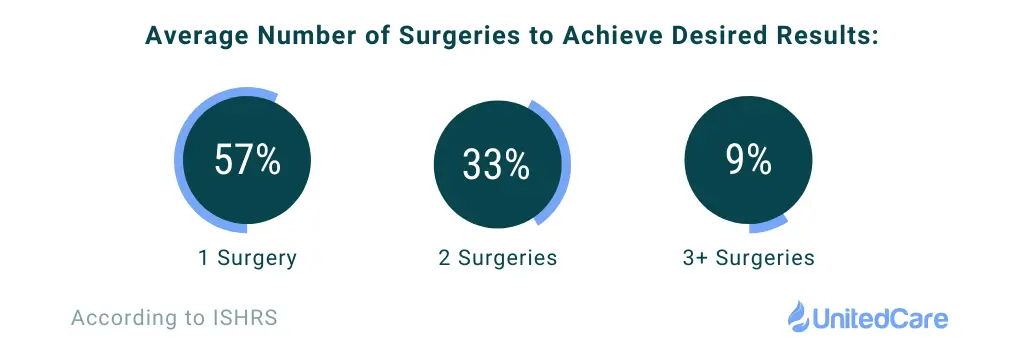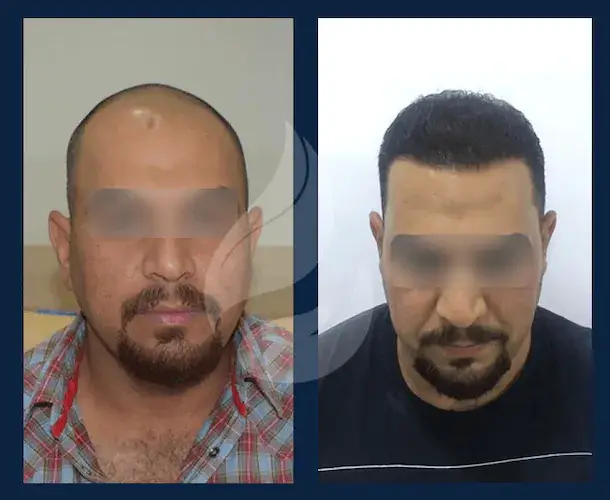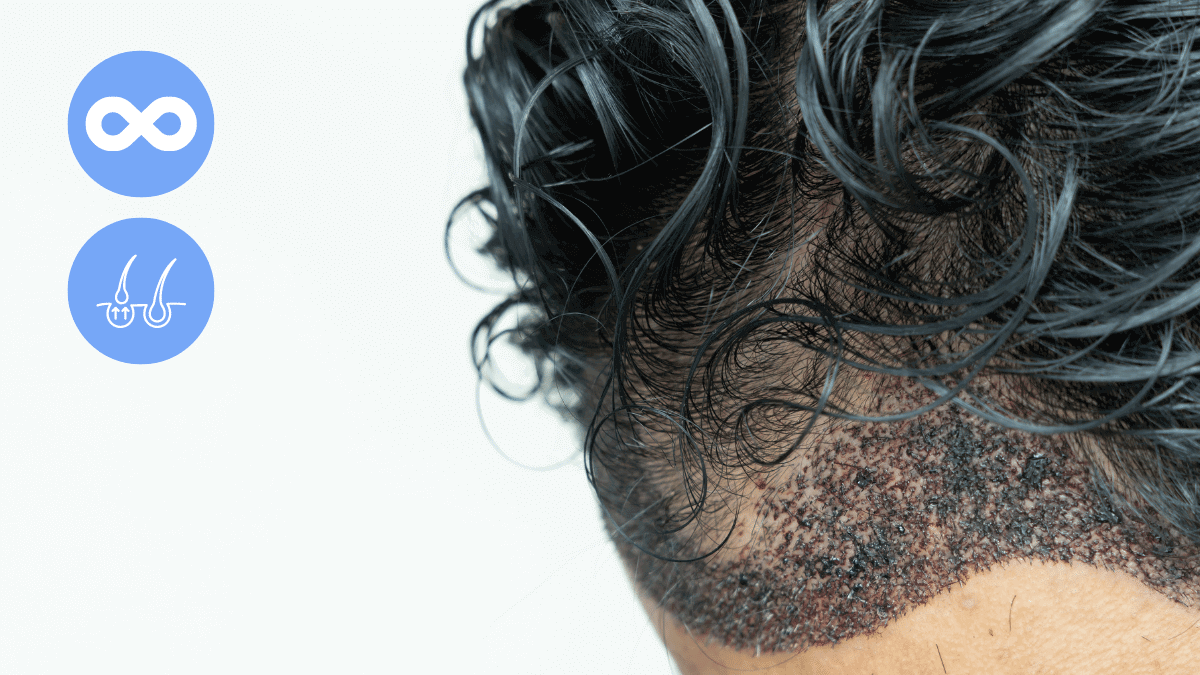TL;DR
➡ There is no clear limit or answer to how many hair transplants a person can have, as it can change for any patient.
➡ It is possible to have multiple hair transplants, but mainly your doctor or how much your baldness has advanced determines this number.
➡ Ideally, we want our patients to avoid conditions that force them to get another hair transplant.
➡ As getting more surgeries can cause serious mental and physical stress on your body, you should ensure that your next one is the last.
Here is a scary statistic: Did you know that according to the ISHRS, it takes the average patient 3.4 surgical procedures to achieve their desired results?
I know that even gathering up the courage to decide on beginning a hair transplant journey was difficult. And now, it seems like simply undergoing a single surgery may not be enough to achieve the great hair you deserve.
But this is no reason to panic; simply a minor obstacle. As with every other medical problem we may face, the first crucial step is knowing why patients may need more than a single transplant so that we can minimize and control the numbers.
The reason an average patient has to have multiple surgeries can be many things, including hair transplant failures that might occur due to poor patient selection, inexperienced staff and surgeons, poor after-hair transplant care, and more.
In this article, I will first explain how many hair transplants you can go through, their effects on your health, and finally, all of the reasons for having multiple transplants in the first place so that you can prevent them:
Table of Contents
Let’s start by getting the obvious question out of the way:
Is It Possible to Have Multiple Hair Transplants?
Yes, in theory, there is no direct limit to the number of hair transplants you can have. So, you can have multiple hair transplants. But in practice, there are certain indicators for determining how many hair transplants your scalp can have:
1️⃣ The number of hair grafts in your scalp: Usually, patients have about 8000 grafts in their head that can be harvested in a lifetime, and their surgeries need about 2000-3000 grafts which allows them to have 2-4 transplants. However, depending on how much your hair loss has progressed, this number can radically get lower, reducing the number of hair transplants you can go through.
2️⃣ The amount of stress your body can receive: Undergoing a hair transplant puts immense physical and mental pressure on your head, if not your entire body. Infections or the cases of your body rejecting the transplanted hair are only among the few possible side effects or risks. So, it is generally a good idea to take your doctor’s advice before deciding when and if you should get another transplant.
3️⃣ The cost of a hair transplant: The cost of hair transplants does get cheaper every year, especially in countries such as Turkey, with the technology for hair transplants getting more and more accessible. However, they are still expensive enough to consider when you are thinking about getting multiple surgeries.
But at the end of the day, if all of these indicators show that you can have more than one single hair transplant, the essential factor we should check now is exactly how many you can have:
How many hair transplants can a person have?
You could theoretically have even more than four hair transplants depending on your hair grafts. However, to combine what I have already mentioned with an example, if a patient were to decide that they want a hair transplant after their baldness has progressed in 3 different parts of their scalp, it is very likely that their scalp will successfully and healthily survive 1-3 surgeries even in their graft numbers were to drop down to 6000.
But, it is impossible to say that they can resolve further hair loss with more transplants as their grafts will be entirely consumed.
So, it is clear that although it is possible to push to number very high, it is in many ways beneficial to minimize the number of hair transplants you plan to go through.
Then why would you need more than one transplant in the first place? Let me explain:
5 Reasons to Get a Second (or Another) Hair Transplant 💡
1- Your hair transplant process may consist of multiple surgeries
Sometimes, like the example I gave earlier, patients can have separate balding areas around their scalps. So, their doctor can choose to plant the grafts in each balding area separately to minimize the duration of the surgery and help your scalp focus on healing one single part at a time.
Alternatively, if a patient has a balding area that has radically progressed to a big size and thus the surgeon will need to plant more than 4000 or so grafts, they simply might choose to do it in more than one session.
The key points here are your doctor and communication. When getting more than one hair transplant becomes a topic solely because of this reason, your doctor will, in no doubt, think of this option and act on it only if it is more beneficial.
2- Your current hair transplant can fail
Even by today’s standards, hair transplant failures are not very uncommon. The critical point to understanding why they would be detrimental in determining whether you want another transplant is that their “success” can be defined differently.
Usually, the success of hair transplants is seen as successful if at least 80% of planted hair grafts survive at least six months after the surgery. In this definition, the failure rate for the average hair transplant can be as low as 5-10%.
But, if you define failure as not achieving complete success in desired looks with a single surgery, the failure rate of hair transplant surgeries would be around 43%, according to ISHRS research which revealed that only 57% of patients achieve their desired results after a single hair transplant operation.
In either method, the surgical process contains many possible scenarios of failure depending on your surgeon’s knowledge and experience, technique, graft count, medicine and supplements used following the surgery, and whether or not you lean towards a healthy lifestyle.
3- You just might not like the results you have

According to ISHRS, only 33% of patients reach their desired results after getting a second hair transplant, leaving 9% looking for more transplants or alternative methods.
That is not a surprising scenario and not one that depends on the patient’s preference. Some patients experience rapidly progressing balding at very early ages due to stress and unhealthy lifestyle habits. Therefore, by the time they decide to get a hair transplant, their head has lost so much hair that a single hair transplant is simply enough to bring their old shining image back.
Similarly, the transplant’s physical shock on your scalp can cause balding to appear in other parts of your head shortly after the surgery. In this case, you may need another surgery to maintain your great outlook.
4- Your hair loss might have progressed
It is crucial that we make one point clear:
⚠️ Hair transplant does not guarantee that further hair loss from other parts of your scalp will not happen.
A hair transplant is a very effective solution for progressed hair loss: balding. A patient can become eligible for it only when a part of their head has experienced balding to such an advanced stage that it is simply not possible to regrow hair in that area naturally or with medications since hair follicles are entirely lost.
However, the hair transplant process only puts hair follicles in the balded area; it does not create a protective effect on the rest of your scalp. So, the rest of your head is simply vulnerable to the effects of hair loss in the long term as well.
Ultimately, for every patient who has experienced male pattern baldness, it is inevitable that they will continue to experience it even after a hair transplant if they choose not to use any supplement medications for preventing hair loss (such as Finasteride). As a result, this decision will cause them to get more transplants.
5- You might want to cover the scar from a FUT surgery
Although better and more modern techniques are slowly replacing FUT surgeries in all the clinics in the world, some still offer FUTs as potential alternatives for patients who request them. Unlike other options, FUTs leave a distinguishable linear scar on your scalp that can be seen long after surgery.
Furthermore, despite being rare, it is possible to have scars from every hair transplant method, depending on your surgeon’s capabilities and the tools they use.
In either case, your head will be left with visible signs of scars due to hair transplants which will be even more visible with a shorter hairstyle. So, patients may need to consider getting another transplant, preferably with an FUE technique this time, to cover up their scars from the previous one.
At the end of the day, when we look at all of these five potential reasons for getting another transplant, we can see that they are pretty common and striking but avoidable. As these are the main reasons that you could ever have for needing another hair transplant, simply knowing some key points and looking out for them can save you from the trouble of undergoing multiple surgeries over and over:
What to Look Out for When Undergoing Another Hair Transplant Surgery
If it has become inevitable that you will go through a hair transplant at some point soon, you can at least look out for some crucial parts and follow them step by step to ensure that this hair transplant stays the last you will ever need:
💠 Understanding the reasons behind the additional surgery: The five reasons I mentioned in this article are crucial for understanding why you may need another hair transplant surgery. And understanding is half the way to ensuring that another surgery will not be necessary. As some patients do not understand these reasons, they simply rely on the idea that if they ever need it, they can get another hair transplant, which as a result, creates a heavy burden on their bodies both physically and mentally.
💠 Working with a dermatologist: As some cheaper clinics that work without dermatologists have less experience and knowledge in the field of hair transplants, they often make mistakes that result in their patients cycling back to the beginning of their hair transplant process. In this case, clinics with dermatologists are critically more important to save patients from this process and give them the reliable consultation they need to ensure their great future with shining hair is just around the corner.
💠 Sharing information about your first surgery with your doctor: Usually, even though it was not a total failure, your first hair transplant experience can hold crucial information about why your head needs a second hair transplant surgery. If you are choosing a different and more prominent clinic for your second hair transplant surgery, telling them that your first one was a failure due to their used method can help them find the right one for you this time. If your hair loss has progressed after your first hair transplant surgery, telling them this can help them find a sustainable hair loss medication to stop hair loss from ever happening after the surgery. That way, you can avoid the need to get another transplant. And lastly, if you have experienced scars on your first hair plant surgery, telling this can help them determine the method for avoiding scars.
💠 Taking natural and medicational supplements: One common misconception patients have is that they put their trust in hair transplant surgeries as a sustainable long-term option for dealing with hair loss. Alas, it is not. A hair transplant ensures that your balding areas will have hair again, but the rest of your head will still be sensitive to hair loss. And continuously relying on hair transplants will either cause your head to run out of hair grafts or experience too much shock loss or physical trauma that the entirety of your hair will be lost. The ideal option is to consult with your doctor to decide on the proper supplementary medications and natural changes in your lifestyle that you can start even before you go through your hair transplant. And you should continue using them long after your surgery is finished if you wish to prevent further hair loss.
And to successfully take all these necessary steps to ensure that your next surgery is the last, you should consult with the right clinic:
Ensure That Your Next Hair Transplant Is the Last 🩺

At UnitedCare, we begin your hair transplant process by offering you a one-on-one consultation with our expert doctors and dermatologists to find the best-suited option together. Our holistic approach provides you with a mix of advanced technologies and bio-enhancements to ensure that you do not need another surgery.
After you have decided on a method, we begin the treatment with the utmost attention. But most importantly, we stay in contact with our patients even long after the treatment has already finished ensuring that the surgery succeeds in becoming a permanent one.
Regardless of which method you choose, one policy in our clinic stays the same. We value creating a balance between your comfort and your health.
Ready to begin the journey? Click here to start the first step:
Minimize the surgeries, and maximize the success.
UnitedCare’s expert dermatologists provide you with a holistic approach to FUE surgeries:
Frequently Asked Questions (FAQs)
How many times can a person go for a hair transplant?
There is no absolute limit to how many times a person can undergo hair transplant surgeries. However, considering a hair transplant’s cost and physical trauma on the body, a patient will likely want to stop getting another hair transplant starting around four or five at some point. Furthermore, hair transplants depend on some hair grafts that contain hair follicles left on your scalp, and these hair grafts directly affect how many hair transplants you can go through. So, if your scalp has a limited amount of hair grafts left due to highly advanced balding, it is likely that your head will not be able to grant your balding areas more than three hair transplant surgeries at best.
Can you do a second hair transplant?
In most cases, getting at least a second hair transplant surgery is safe and possible. In fact, it might even be necessary as a patient’s situation can naturally require multiple hair transplant surgeries. Sometimes, when a patient has a balding area that has expanded to a considerable size, a surgeon may choose to plant the necessary hair grafts in multiple sessions rather than one to minimize the time spent in surgery and give the patient’s body some time to heal. Or, in an alternative scenario, if a patient were to experience multiple, separate balding areas around their scalp, their surgeon can choose to transplant hair grafts in each of them on only one surgery at a time. In these instances, a second transplant is a healthier and safer choice.
How many hair transplants do most people need?
According to many worldwide hair transplant statistics resources, including ISHRS, the average patient requires 3.4 hair transplant surgeries to achieve their desired results. Another statistic shows that only 57% of patients achieve this goal in a single hair transplant surgery alone. As every patient’s need and desire for needing multiple surgeries can differ, it is safer to look at what can be done to minimize the number of hair transplant surgeries to undergo. Any need for a hair transplant comes with irredeemably progressed balding areas. So, finding the proper consultation, dermatologist, and attention to your hair’s health through natural and medicational supplements after the surgery will reduce the number of necessary hair transplants needed to one or at least two.
How many times can FUE be done?
As with every hair transplant method, the number of FUE hair transplant surgeries you can go through depends on your choice and the number of hair grafts on your scalp. There are only two factors for FUE that are not present in other methods. Firstly, the simpler and more obvious one is that the FUE method is more modern and thus more costly. So, preferably patients choose this method only after getting a second hair transplant surgery becomes inevitable, and they want to ensure that this one becomes the last or at least not too many times. Secondly and more importantly, due to it being more effective as a modern technique, it is likely that the number of times you will need another FUE hair transplant surgery will be less than other methods. So, in theory, aside from your hair grafts limiting it, you can get FUE limitlessly. However, due to its effectiveness, you will likely not need it more than two times.

